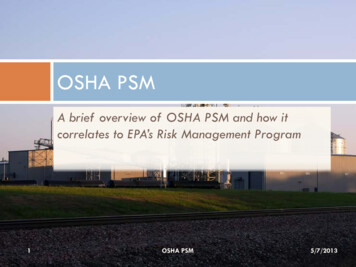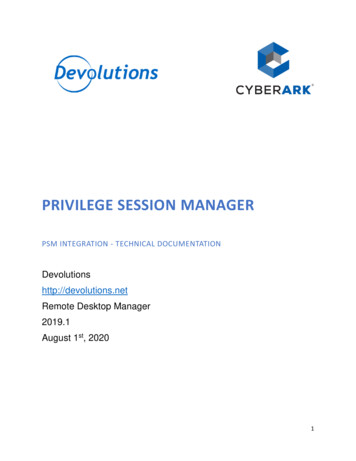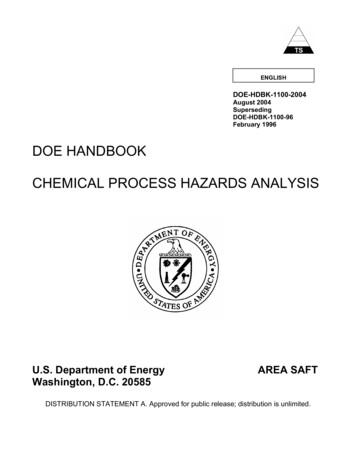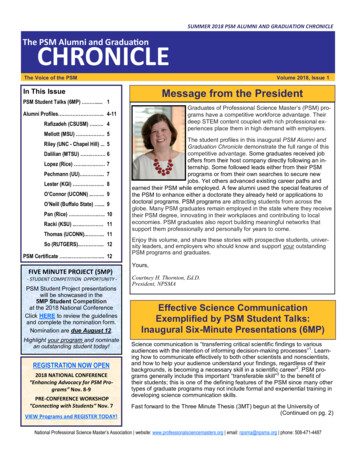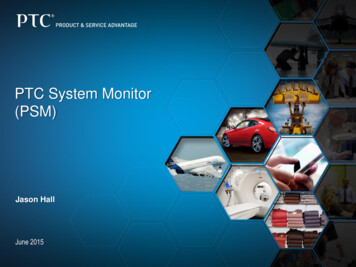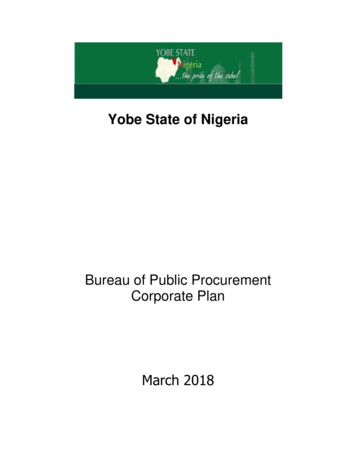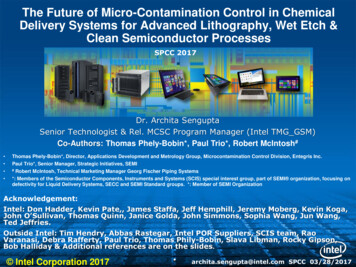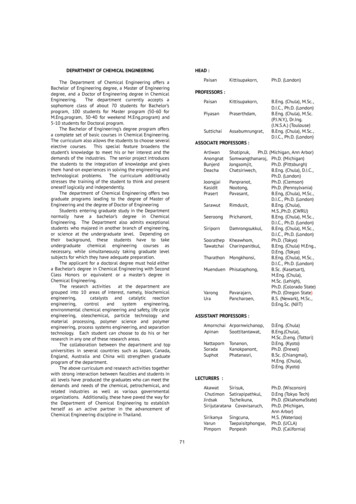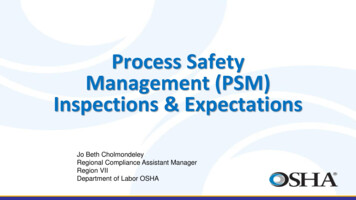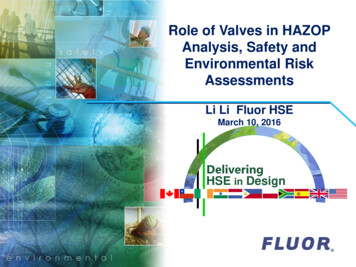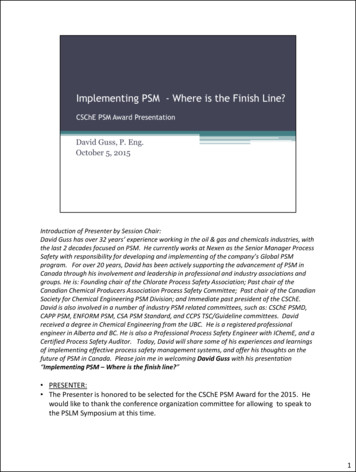
Transcription
Introduction of Presenter by Session Chair:David Guss has over 32 years’ experience working in the oil & gas and chemicals industries, withthe last 2 decades focused on PSM. He currently works at Nexen as the Senior Manager ProcessSafety with responsibility for developing and implementing of the company’s Global PSMprogram. For over 20 years, David has been actively supporting the advancement of PSM inCanada through his involvement and leadership in professional and industry associations andgroups. He is: Founding chair of the Chlorate Process Safety Association; Past chair of theCanadian Chemical Producers Association Process Safety Committee; Past chair of the CanadianSociety for Chemical Engineering PSM Division; and Immediate past president of the CSChE.David is also involved in a number of industry PSM related committees, such as: CSChE PSMD,CAPP PSM, ENFORM PSM, CSA PSM Standard, and CCPS TSC/Guideline committees. Davidreceived a degree in Chemical Engineering from the UBC. He is a registered professionalengineer in Alberta and BC. He is also a Professional Process Safety Engineer with IChemE, and aCertified Process Safety Auditor. Today, David will share some of his experiences and learningsof implementing effective process safety management systems, and offer his thoughts on thefuture of PSM in Canada. Please join me in welcoming David Guss with his presentation“Implementing PSM – Where is the finish line?” PRESENTER: The Presenter is honored to be selected for the CSChE PSM Award for the 2015. Hewould like to thank the conference organization committee for allowing to speak tothe PSLM Symposium at this time.1
As mentioned in the introduction, the presenter will share some of his experiencesand lessons learned with implementing PSM over the last 20 years. He will alsoshare his thoughts on what the future might hold for PSM in Canada. There shouldbe time at the end of the presentation for some questions.2
3
The presenter will share some of the lessons learned over his 20 years experienceimplementing PSM1980’s When presenter was attending university for Chemical Engineering Degree, PSM was notpart of the program. And when he started work, PSM was not formally discussed in oil/gasindustry. But this was before the Mexico City (PEMEX, Nov 19, 1984, 600 dead), Bhopal(UC, Dec 2, 1984, 3000 dead), Piper Alpha (Oxy, July 6, 1988 - 167 dead) and PasadenaTexas (Phillips, Oct 23, 1988, 24 dead) disasters. Major Industrial Accidents Council of Canada (MIACC) formed 1987 – alliance ofgovernment, industry, non-government groups. Dissolved in 1999. CCPS “Guidelines for Technical Management of Chemical Process Safety”, 19891990’s In the early 1990’s, presenter was first introduction to PSM through the implementation ofthe CIAC (formerly CCPA) Responsible Care program in a small chemical plant (RC was rolledout starting in 1988, updated 1992) Importance of PSM became very evident, when presenter was involved in incidentinvestigation of explosion at another chemical plant in same company in 1994. You mayknow how devastating the effects of PSM events can be, but it really sinks in when you seefirst hand the effects on people, environment and property. Presenters personal story. Formed chlorate process safety association to share PS lessons learned with peer companies.It was possible to work with direct competitors with common goal of making the industrysafer. Participants had to sign agreement to participate.4
API RP 750 Management Process Hazards in 1990 API RP 75 SEMP in 1992 CCPS “Plant Guidelines for Technical Management of Chemical Process Safety”, 1992.Original 12 elements of PSM. USA OSHA PSM Regulations, 1992 and USA EPA RMP Regulations UK HSWA Act 1974, Offshore Installations (Prevention of Fire and Explosion, and EmergencyResponse) Regulations 1995 (PFEER), Offshore Installations and Wells (Design andConstruction, etc.) Regulations 1996 (DCR) UK COMAH Regulations in place 1999 to implement Seveso 2 Directive MIACC Site Self Assessment Tool 1999, updated 2001. MIACC guidelines for “risk based landuse planning”, and “risk assessment RP for municipalities and industry” CIAC PSM Committee in late 1990’s and in 1999 CSChE PSM Subject Division. Two groupshad join meetings. 1999 Environment Canada CEPA E2 regulations 1998 US CSB became operational4
2000’s CSChE PSM Division is individual members who check off PSM as subject division(now up to about 300). Budget 1 k CCPS Tech Steering committee (TSC) different in that member company joins CCPSand company rep attends TSC meetings. Budget 1 M More PS incidents in 2000’s: Toulouse France (AZF Sept 21, 2001, 29 dead), BP TexasCity incident (March 2005, 15 dead, 170 injured), lead to more focus on processsafety culture and KPI’s. In 2007, Baker Report caught attention of Boards. In 2003, OECD issued Guiding principles for chemical accident prevention,preparedness and response In 2007, CCPS issued Guidelines for Risk Based Process Safety with 20 elements. In 2008, OGP Asset Integrity – key to managing major incident risks Georgia sugar refinery explosion Feb 7, 2008 , Dust explosion 14 dead. Guidelines onpreventing dust explosions In 2009, CCPS issued PS leading and lagging metrics guideline. Followed by API RP754 in April 2010 , OGP Report 456 in Nov 2011, and CAPP PSM event reportingguide 2015. In 2009, updated API RP 752 for permanent buildings, in 2007 API RP 753 portablebuildings.2010’s 2010 Energy Institute PSM Framework5
BP Macondo well blow out (June 2010, 11 dead, 5 million barrels of oil lost) resultedin new regulations in USA (US BSEE SEMS 2 Oct 2010). Company PSM program wentbeyond regulations. CSChE PSMD PSM standard, guide 2012 and PSM audit protocol 2013 West, Texas Fertilizer explosion (April 17, 2013, 15 dead mostly first responders) Lac-Magantic rail incident in July 6, 2013 resulted in 47 dead. Improved railregulations in Canada and USA. Tianjin China explosion (Aug 12, 2015), 173 dead - most of causalities were firefighters and police BC OGC LNG Facility Regulations, 2014 includes risk criteria O&G Industry: IOGP PSM Committee, CAPP PSM Committee and Enform PSMSteering committee Canadian CSA PSM standard – draft issued for public comment and deadline is Oct 7,20155
What were some of the key Learnings of the presenter from 20 years of implementingPSM in chemical and oil/gas companies?LEADERSHIP – An effective PSM system starts with Leadership Commitment and Accountability. Sometimes this happens after a catastrophic event in a company. But small and midsize companies may survive this level of event so they need to learn from experienceof others. After the Baker report was issued in Jan 2007, many company boards were askingquestions about can this happen here and what are we doing to ensure it does not? May have to overcome “it hasn’t happened here” or “it can’t happen here becausewe are better/different than the other guys” bias Holding persons accountable by including safety in individual’s performance reviews.Require everyone to include a personal performance goal related to safety. Leaders should engage employees at all levels of organization. May need to coachsome leaders on how to talk to field workers about process safety. They need to usethe correct language: personal safety vs process safety. Coaching leader to talkabout “process safety”, but said “production safety”. Powerful for leaders to visit field during or after PS incident to show they care aboutwell being of people and offer support. Strong leaders at different levels of the organization CEO to field operator, but fieldoperator at risk so they have most to gain from effective PSM. Steering Committeewith VP Operations.6
People are watching leaders all the time, so they need to talk and act in a way thatsupports the organization’s values and beliefs about safety. Message needs to be consistent, i.e. ask operations to improve PSM performance,but at same time reduce maintenance budgets (e.g. BP Texas City) Should understand different social cultures at different locations/countries, or aftermergers. For example the difference from NA vs middle east vs Asia. Don’t assumepeople will act the same across the globe. Give people the authority and responsibility to stop unsafe work – more aboutpersonal safety but also support strong PS culture if people can speak up if they thinksomething is wrong, i.e. space shuttle challenger Leaders who share a personal story about process safety events have must strongerimpact on work force.6
DEFINING AND PLANNING A management system is a self sustaining initiative that achieves a specific set ofgoals Process Safety Management (PSM) is a disciplined framework for managing theintegrity of hazardous operating systems. Many frameworks, systems and approaches: CSChE PSM Standard, CCPS RBPS, OSHAPSM, UK HSE Safety Case/COMAH, US BSEE SEMS/API RP 75, IOGP AI, EnergyInstitute PSM, etc. Refer to CAPP PSM Regulatory Scan August 2014 Pick a internationally recognized one that is fit for purpose for the organization. NoISO PSM standard yet, but maybe CSA PSM will be seed document for one in thefuture? Presenter has experience with using CCPS RBPS adapted for upstreamOil/Gas, including Drilling & Completions, and recently resource development(i.e. oil/gas reservoirs). In industry, there have been recent cases where therewas LOPC from reservoir through cap rock. Best to integrate with other related management systems: Health, Personal Safety,environment, security, QA/QC, Asset Integrity, Operations Excellence Gap analysis should be against agreed framework and done by qualified personnel.Requirements may need to be translated in terms that can be understood bypractioners Developing and implementing a PSM system can take a lot of time and resources.7
Use resources efficiently, but plan according to the scope and complexity of theimplementation effort. It may take years and M. Identify key milestones.May get push back on the costs if there are financial constraints (e.g. downturn). Costbenefit analysis may help justify the spend.May be difficult to find or develop qualified resources to support development,implementation and sustainment of PSM programs. If use external resources,knowledge may leave with them. PS Engineering could be a good career path.Integrating PSM into other business initiatives may make for more efficientimplementation, e.g. OE or reliability improvements.Involving the correct stakeholders from the start, i.e. in addition to O&M, HSE andEngineering, also include: change management, HR (training, MOOC) , projectmanagement, supply chain, marketing, ITUnderstand regulatory requirements – some regulations are prescriptive (OSHA PSMor API 14C) and others are performance base (UK HSE Safety Case).The degree of how centralized or decentralize the PSM systems are will depend onthe structure of the organization. Need to find the correct balance for the specificorganization.7
For some leaders, PSM was new and they required coaching and mentoring onwhat to do and say. For example, process safety not the same as personal safetyRoles, responsivities and accountabilities need to be clearly defined. PSMCoordinator was a new role formed to support implementation of PSM. Whenthings are not getting done, everyone should know who is responsible andaccountable (e.g. review overdue actions at stewardship).Implementation plan should prioritize elements based on risk/opportunity.Don’t do it all at once—this leads to initiative overload on the organization. Forexample, based on gap analysis, may start with MOC, PSI, HIRA, AIaR etc.Formal change management process can ensure new programs, processes,systems, are implemented effectively and sustainable. Not enough to developnew standards and procedures and issue them. Need to “socialize” them withthe workers.May have resistance to change, need to prepare for this and deal with itappropriately—strong and clear message from leaders that we are movingforward with PSM and we expect everyone to support it.Monitor progress of implementation, i.e. use KPI’s to measure % complete withimplementation. For example, could use 5 Levels of maturity model.Acknowledge and celebrate successful completion of milestones/keydeliverables.8
Important for ongoing communications at all levels of organization. Gap incommunication can be filled with rumours.Share experiences and leverage lessons learned with different parts oforganization and other companies. Good way of doing this is use of internal andexternal communities of practice.8
During and after implementation of PSM programs, need to monitor theeffectiveness of program. Assurance activities should be done on regular basis by qualified personnel. Ask ifthe processes and procedures are being used/followed? Conduct self assessments or self audits on planned basis (e.g. annually). Conduct formal independent management system audits as needed, e.g. every 3years. Use recognized process, e.g. ISO 19011 and trained auditors. Give facility timeto complete recommendations before auditing again. However, if they cannotaddress the issues in a timely basis, then there may be issues with leadershipcommitment/accountability, competing priorities and or lack of resources. Develop appropriate KPIs for measuring PS performance, i.e. leading and laggingindicators, and that will help organization monitor and improve performance.Edwards Deming (1900-1993): “Can’t manage, what you don’t measure”. Refer to CCPS Guidelines on PSM performance indicators, API RP 754, and OGPReport 456. Pick ones that fit the organization, but also have some KPIs that allowfor external benchmarking, i.e. API RP 754 Tier 1 and 2 process safety events andrates.9
Organization should be clear about its commitment to continuous improvement Stewardship process should include review of the performance information.Management should address areas that are off track. Strategy may need to be revised to respond to significant changes, e.g. newregulations BSEE SEMS, critical incident Need to manage changes in plant, people, process, and systems. Organizational changes can be a big challenge. With down turn in O/G, layoffs mayhave left some gaps in organization. Is there an effective process in place to managerisk of these type of org changes? Keep key stakeholders informed on your progress and performance. This couldinclude Shareholders, Board, Executive, Management, Employees, Contractors,Customers, Suppliers, Regulators, Community, insurers, special interest groups, andothers. Reporting performance (Tier 1 & 2 PSE) to external groups, such as industryassociations such as CIAC, CAPP, OGP10
Concerns of Stakeholders What is the level of public concern regarding PS incidents in Canada? May not behigh on agenda for current federal election, but it is important to people that havebeen effected by PS events, e.g. Lac Megantic in July 2013 News and social media coverage of incidents is more intense that ever anddistributed globally almost instantly. Expectations of society on processing industries will increase over time, as they havebeen over the last 50 years. What level of risk is generally accepted by Canadian society? Is it 10E-6, 10E-7, or10E-8? MIACC land use guidelines 10E-6 and 0.3x10E-6 Public is more educated about the HAZARDS, but they are not risk experts. Still havework to do to better explain the risks of industry.PSM Regulations in Canada Although no formal federal PSM regulations, new CSA PSM standard may bereferenced in regulations going forward.PSM in Education Some engineering schools in Canada offer courses related to PSM, but not allchemical engineering schools do at this time. Work is under way to change this. U ofT on line PSM training modules, U of A Engineering Safety and Risk managementProgram, Dalhousie Risk & Loss Control Management are some examples of bring11
PSM into the universities, but ways to go to get in all Chemical Engineering schoolsacross Canada. Hopefully within the next few years this will be the case. But not just chemical engineers. All Engineers, should have basic understanding ofPSM before they graduate, e.g. U of A. Not award of any Masters degrees in PSM in Canada at this time, so engineers arelooking to schools like Texas A&M in USA and Heriot Watt in UK.PS Engineer Designation IChemE Professional Process Safety Engineer, AICHEM / CCPS Certified Process SafetyEngineer are relatively new. Presenter was 1 of first 2 to get first IChemE PPSEdesignation in Canada, and is currently working on beta testing for CPSE from CCPS. APEGA does not list PS Engineer as recognized engineering role.Canadian CSB It would be good to have a federally run group to investigate and report on processsafety incidents for all industries. Similar to the US CSB. Now it is difficult to get information about events that happen in Canada, e.g. sunrisepropane incident.Passionate Leaders and Professionals MIACC 1987 to 1999 lead by passionate persons. CSCHE PSM Division – lead by passionate PS professionals. They volunteer a lot oftheir time to progress the state of PSM in Canada, e.g. CSA PSM standard. PSMDivision Risk Expert Committee is also updating risk guidelines for Canada More industrial associations are supporting PSM: CIAC PSN, CAPP PSM Committee,ENFORM PSM steering committee11
To summary some key points from Presentation:PSM in Canada is still evolving PSM have improves a lot since presenter started working in the industry 30 yearsago. PSM will continue to evolve as we share our improve our understanding of how toeffectively sustain good PSM performance More sharing of information in industry will enable us to all improve. A significantincident in one company can effect the others in the industry (Macondo)Incidents After PS incidents occur, it often leads to new regulations, standards and codes.Raising the bar. Unfortunately PS incidents are still occurring with causes similar to previous events.Need to watch for normalization of deviation or risk. But getting better at sharing lessons learned, e.g. Sun Bruno near San Franciscopipeline gas explosion (8 dead) in Sept 2010 Atco gas replacing their pipelines inAlberta. Implementing PSM Implementing PSM effectively can take a lot of resources and time, so plan andbudget accordingly. Make the PS MS fit for purpose for the organization.12
Understand Stakeholder Listen to your stakeholders and address their concernsContinue improvement and strive to be better than yesterday Have passion and chronic uneaseFinish Line So where is the finish line? Maybe when we are able to successfully operate ourfacilities without having a serious process safety event everyday, not just for a week,a month, a year, or even a decade, but for the life of a facility. Presenter end quote: I AM STILL PASSIONATE ABOUT PSM AFTER 20 YEARS, BECAUSE I BELIEVETHAT WHAT WE DO AS PROCESS SAFETY PROFESSIONALS CAN SAVE LIVES.AND IF I CAN SAVE ONE LIFE IN MY CAREER, IT IS WORTH ALL THE HARD,CHALLENAGING AND, AT TIMES, FUSTURATING WORK. I HOPE YOU SHARETHAT SAME PASSION.”12
Thank you for our attention.Time Permitting ask if there any questions?13
CCPS Tech Steering committee (TSC) different in that member company joins CCPS and company rep attends TSC meetings. Budget 1 M More PS incidents in 2000's: Toulouse France (AZF Sept 21, 2001, 29 dead), P Texas City incident (March 2005, 15 dead, 170 injured), lead to more focus on process safety culture and KPI's.
